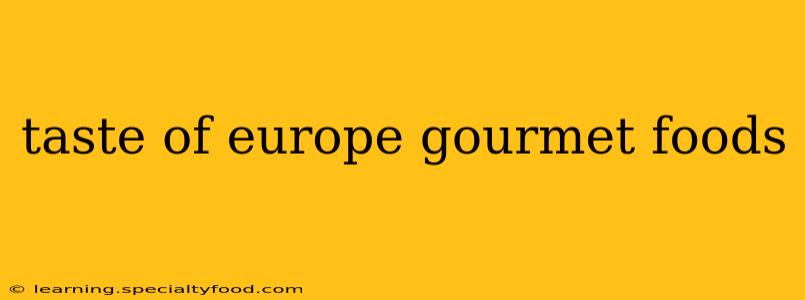Europe, a tapestry of diverse cultures and histories, boasts a culinary landscape as rich and varied as its people. From the rustic charm of Italian pasta to the delicate flavors of French pastries, a journey through European gastronomy is an adventure for the senses. This exploration delves into the gourmet foods that define different European regions, highlighting their unique ingredients, preparation methods, and cultural significance.
What are some popular European gourmet foods?
This is a question with many delicious answers! Popular gourmet foods vary greatly depending on the region, but some standouts include:
-
France: Fine cheeses (Brie, Camembert, Roquefort), delicate pastries (macarons, croissants), rich sauces (béchamel, hollandaise), and exquisite wines. French cuisine emphasizes fresh, high-quality ingredients and masterful techniques.
-
Italy: Artisan pasta, handcrafted cheeses (Parmigiano-Reggiano, Pecorino Romano), sun-ripened tomatoes, fragrant olive oil, and robust wines. Italian food is characterized by its simplicity, highlighting the natural flavors of the ingredients.
-
Spain: Paella, tapas (small plates of diverse dishes), Iberian ham (Jamón Ibérico), and flavorful olive oils. Spanish cuisine is known for its vibrant flavors and use of fresh seafood.
-
Greece: Seafood, olives, feta cheese, and vibrant salads. Greek cuisine showcases the bounty of the Mediterranean Sea and emphasizes fresh, healthy ingredients.
-
Germany: Sausages (Bratwurst, Currywurst), pretzels, dark bread, and hearty stews. German food is known for its comforting and filling dishes, often featuring rich meats and potatoes.
What are some lesser-known European gourmet foods?
Beyond the well-known favorites, Europe offers a treasure trove of lesser-known gourmet delights:
-
Portugal: Pastel de Nata (custard tarts), seafood stews, and Vinho Verde (a slightly sparkling green wine).
-
Netherlands: Stroopwafels (thin waffles with caramel syrup), bitterballen (deep-fried meatballs), and Gouda cheese.
-
Sweden: Smørrebrød (open-faced sandwiches), pickled herring, and cloudberries.
-
Hungary: Goulash, chimney cakes (kürtőskalács), and Tokaji wine.
-
Scotland: Smoked salmon, shortbread, and Scotch whisky.
Where can I find authentic European gourmet foods?
Authenticity is key when experiencing gourmet European foods. While many specialty stores offer imported goods, seeking out local markets and artisanal producers can offer a truly immersive experience. Consider:
- Farmers' markets: These offer a chance to sample regional specialties directly from the producers.
- Specialty food shops: Many cities boast shops dedicated to importing and selling gourmet European foods.
- Restaurants: Look for establishments that emphasize locally sourced ingredients and traditional cooking methods.
- Online retailers: Be cautious and research thoroughly before purchasing online, ensuring the seller is reputable and the products are authentic.
What makes European gourmet foods so special?
The special quality of European gourmet foods stems from a confluence of factors:
- Regional specialties: Each region has its unique ingredients and culinary traditions, resulting in a vast array of flavors and styles.
- High-quality ingredients: Many European producers focus on sustainable farming practices and high-quality ingredients.
- Traditional techniques: Many recipes have been passed down through generations, maintaining centuries-old techniques.
- Cultural significance: Food often plays a central role in European culture, representing traditions and history.
How can I recreate the taste of Europe at home?
Bringing the taste of Europe home is achievable with a little research and effort:
- Source high-quality ingredients: Look for authentic ingredients, like specific cheeses, oils, and spices.
- Find authentic recipes: Look for recipes from reputable sources, including cookbooks and online resources, ensuring accuracy and authenticity.
- Experiment and adapt: Don't be afraid to experiment and adapt recipes to your preferences and the ingredients available to you.
By exploring the diverse culinary landscape of Europe, you'll discover a world of flavor and tradition. So embark on your own gastronomic adventure, and savor the unique and delicious gourmet foods this continent has to offer.
